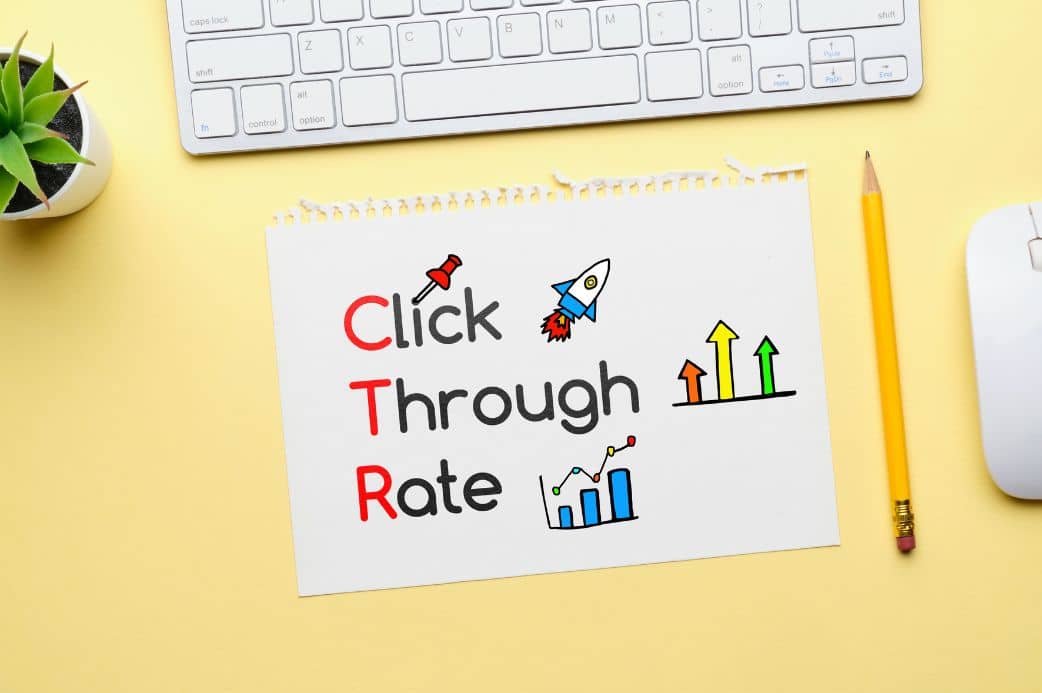In today’s digital landscape, where information is just a click away, businesses and content creators face a critical challenge: capturing their target audience’s attention. One of the most vital metrics in this pursuit is the Click-Through Rate (CTR). Whether you’re running an online ad campaign, managing a website, or crafting engaging content, understanding and improving CTR can significantly impact your success.
What is Click-Through Rate (CTR)?
Click-Through Rate (CTR) is a metric that measures the effectiveness of your content or ads in persuading users to take a specific action, usually clicking on a link. It’s calculated by dividing the number of clicks by the number of impressions (or views) and then multiplying by 100 to get a percentage.
Why is CTR Important?
CTR is a key performance indicator because it provides valuable insights into the relevance and attractiveness of your content or ads. A high CTR indicates that your content resonates with your audience and that your call-to-action is compelling. Conversely, a low CTR suggests that your content might not be engaging enough or that your targeting isn’t accurate.
Factors Influencing CTR:
- Relevance: The content or ad should align with the audience’s interests and needs. Irrelevant content is likely to be ignored.
- Clarity: The call-to-action (CTA) should be clear and easy to understand. Users should know what to expect when they click.
- Visibility: The placement of your link or CTA matters. It should be prominently displayed, ideally near the beginning of your content.
- Value Proposition: Users need a reason to click. Highlight the benefits or value they’ll gain from clicking on your link.
- Visual Appeal: Visual elements, such as images or graphics, can enhance the appeal of your content or ads and increase CTR.
- A/B Testing: Experiment with different headlines, CTAs, and visuals to identify what resonates best with your audience.
Ways to Improve CTR:
- Craft Compelling Headlines: Your headline is often the first thing users see. It should be attention-grabbing, relevant, and evoke curiosity.
- Optimize Meta Descriptions: For search engine results or social media, craft concise and compelling meta descriptions that give users a reason to click.
- Use Strong CTAs: Clearly state what users can expect after clicking. Strong CTAs can entice users to take action.
- Mobile-Friendly Content: With the majority of users on mobile devices, ensure your content is responsive and easy to interact with on smaller screens.
- Loading Speed: Slow-loading pages can discourage users from waiting. Optimize your website’s speed to retain user interest.
- Segmented Campaigns: In advertising, segment your audience to deliver more personalized and relevant ads.
- Quality Content: Whether it’s a blog post or an ad, the quality of your content matters. Valuable, well-crafted content attracts more clicks.
- Social Proof: Reviews, testimonials, and social media engagement can build trust and increase CTR.
In the ever-evolving world of digital marketing, where user behavior and preferences shift rapidly, understanding the intricacies of Click-Through Rate (CTR) is just the beginning. While a high CTR is indicative of engaging content or effective ads, it’s crucial to delve deeper to fully comprehend the impact of your efforts and make informed decisions.
Conversion Rates
Clicking a link is just the initial step; the ultimate goal is to convert that click into a valuable action. Whether it’s making a purchase, signing up for a newsletter, or filling out a contact form, tracking the conversion rates after the click provides a more comprehensive view of your campaign’s success. A high CTR followed by a low conversion rate could indicate a disconnect between your ad’s promise and the landing page’s content.
User Engagement
Clicks are a form of engagement, but they’re not the only metric to consider. Once users arrive at your content, how long do they stay? Do they explore further, read multiple articles, or interact with different sections of your website? Monitoring user engagement metrics like bounce rate, time on page, and pages per session can help you determine if your content is holding users’ attention and providing value beyond the initial click.
Quality of Traffic
Not all clicks are created equal. The source of your traffic matters. Are users coming from sources that are genuinely interested in your content, or are they clicking out of curiosity? Analyzing the sources of your traffic, such as organic search, social media, or paid advertising, can help you gauge the quality of your audience and whether your targeting strategies are effective.
Brand Exposure and Recall
Sometimes, the impact of a click goes beyond immediate actions. Users might click on an ad to learn more without making an immediate purchase. However, this interaction can leave a lasting impression and contribute to brand exposure. These users might recall your brand when making a related purchase in the future, even if they didn’t convert on the initial click.
Data-Driven Optimization
The insights gained from analyzing CTR, conversion rates, and engagement metrics allow you to optimize your campaigns strategically. If a particular ad has a high CTR but a low conversion rate, you can experiment with different landing pages or calls-to-action. Data-driven decision-making enables you to fine-tune your content, targeting, and user experience for better overall results.
Long-Term Relationships
Focusing solely on the click can be short-sighted. Building lasting relationships with your audience involves consistent delivery of valuable content over time. If your content consistently delivers on the promise made in your ads, users are more likely to return and engage with your brand over the long term.
Conclusion
Click-Through Rate is a pivotal metric, offering insights into the initial allure of your content or ads. However, the real value lies in understanding what happens after the click. By exploring conversion rates, engagement metrics, and the quality of traffic, you can make informed decisions that lead to a more holistic and impactful digital strategy. Beyond clicks, it’s about forging meaningful connections with your audience, leaving a lasting impression, and nurturing relationships that extend far beyond a single interaction.
Frequently Asked Questions (FAQs) about Click-Through Rate (CTR)
1. What is Click-Through Rate (CTR)?
Click-Through Rate (CTR) is a metric used in digital marketing to measure the effectiveness of an advertisement, link, or content in enticing users to click on it. It is calculated by dividing the number of clicks by the number of impressions (or views) and then multiplying by 100 to get a percentage.
2. Why is CTR important in digital marketing?
CTR is crucial because it provides insights into the performance and engagement of your content or ads. A high CTR often indicates that your content is resonating with your audience and that your call-to-action is effective. It helps you assess the relevance and appeal of your campaigns.
3. What is a good CTR?
The definition of a “good” CTR varies depending on the industry, platform, and type of content or ad. Generally, a CTR around 2-3% can be considered average, while 5% or higher is often considered good. However, benchmarks can differ significantly, so it’s essential to compare your CTR against industry standards and your specific goals.
4. How can I improve my CTR?
There are several strategies to improve CTR:
- Craft compelling headlines and meta descriptions.
- Use clear and persuasive calls-to-action (CTAs).
- Ensure your content or ad is relevant to your target audience.
- Optimize the visual appeal of your content with images and graphics.
- Implement A/B testing to identify what resonates best.
- Ensure your content is mobile-friendly and loads quickly.
- Consider the placement of your links or CTAs for better visibility.
5. Can a high CTR guarantee success?
While a high CTR is a positive indicator, it doesn’t guarantee success on its own. It’s essential to track other metrics, such as conversion rates and user engagement, to understand the complete picture. A high CTR followed by low conversion rates might indicate a gap between user expectations and the content on your landing page.
6. How can I track conversions after the click?
Tracking conversions involves monitoring the actions users take after clicking your link or ad. This could include purchases, sign-ups, downloads, or any other desired actions. You can set up conversion tracking through tools like Google Analytics or tracking pixels provided by advertising platforms to gain insights into post-click behavior.
7. What’s the relationship between CTR and engagement metrics?
CTR measures the initial click, while engagement metrics like bounce rate, time on page, and pages per session delve deeper into user behavior after the click. Monitoring engagement metrics helps you understand how well your content retains users’ attention and whether they find value beyond the initial interaction.
8. Is CTR the only metric that matters in digital marketing?
No, CTR is just one of many metrics that contribute to a comprehensive understanding of your digital marketing efforts. Other metrics like conversion rates, return on investment (ROI), engagement metrics, and customer lifetime value provide a more holistic view of your campaigns’ effectiveness.
9. Can CTR be misleading?
Yes, CTR can be misleading if it’s considered in isolation. A high CTR doesn’t necessarily guarantee success if it doesn’t lead to meaningful actions or conversions. Additionally, factors like click fraud or accidental clicks can artificially inflate CTR without delivering actual value.
10. How often should I monitor CTR?
Regular monitoring of CTR is essential to identify trends and make timely adjustments to your campaigns. The frequency of monitoring can vary based on your campaign objectives and the platforms you’re using. It’s recommended to review your CTR at least weekly or monthly and adjust your strategies accordingly.
Remember that while CTR is a valuable metric, a holistic approach to digital marketing involves analyzing a range of metrics to make informed decisions that drive sustained success.











